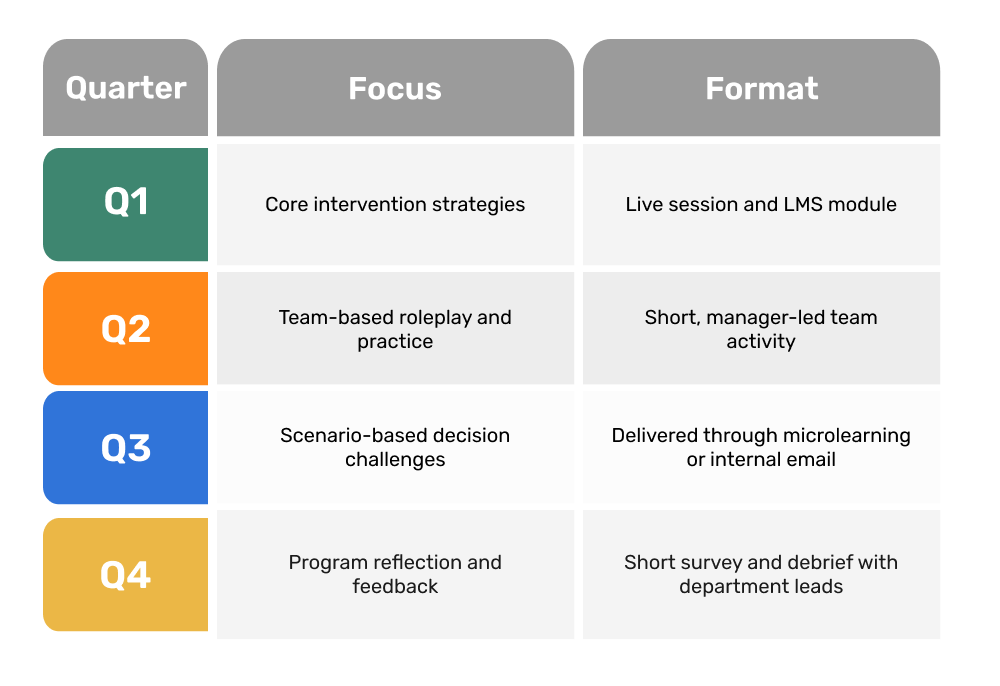In any workplace, culture is shaped by what people allow to happen around them. When employees witness inappropriate or exclusionary behavior and say nothing, it sends a clear signal: speaking up is risky, and silence is expected. That silence often causes more harm than the original act.
This is why bystander intervention training is really important. It helps employees learn how to step in, redirect, or report behavior that goes against your values early, informally, and effectively.
But as HR and L&D professionals, you know that training alone isn’t enough. To embed intervention into your culture for the long haul, you need structure, reinforcement, and manager support to carry it forward.
This blog shows you how to build that plan and how to make your training investment deliver cultural change.
Start with Effective Training and Then Build Around It
Before you can shape culture, you need to give people the right skills and confidence to speak up and take action. Our Bystander Training course focuses on real workplace situations, practical responses, and tips that are simple to apply.
What your teams will learn:
- Understand the Bystander Effect and why people hesitate to act
- Apply the StepUP! Method to assess and respond in real situations
- Use the 5 D’s of Bystander Intervention (Direct, Distract, Delegate, Delay, Document)
- Identify the right way to intervene based on relationships and context
- Take appropriate steps after intervening to support a resolution
Effective training lays the foundation, but sustainable culture change depends on the structure you build around it. Here’s how to build that structure.
Step 1: Define Clear Outcomes
Start by identifying the shifts in behavior and team dynamics you want to see. This gives your training efforts focus and direction.
Set clear outcomes such as:
Before training your teams, review existing data from stay interviews, exit interviews, survey results, and case trends. Use this to decide where to focus and what progress to track.
Step 2: Prepare Managers to Lead, Not Just Observe
Employees often test the waters by raising concerns informally. Whether those concerns go anywhere depends on the manager. Their reaction sets the tone for everything that follows.
What managers should know and do:
Don’t wait until after the training to involve managers. Bring them in early so they can help shape the conversation and understand their role in reinforcing it.
Step 3: Customize Training to Real Workplace Scenarios
Generic content doesn’t stick. Use examples from your actual environment to make the learning more relevant.
Common workplace examples to use:
Encourage employees to choose the path that fits their style, whether it’s stepping in directly, offering support to a peer, or raising the issue quietly.
Step 4: Plan What Happens After the Training
The most common mistake is running the session, sending out a quiz, and considering it complete. Culture shifts when behavior changes, and that takes reinforcement.
Post-training actions that make a difference:
These actions are lightweight. But together, they normalize bystander action as part of how your teams work.
Step 5: Measure Whether Culture Is Changing
Completion rates and attendance don’t mean the training worked. Look for signs that behavior is improving.
Practical indicators to monitor:
Review this data after 60–90 days. Use it to adjust how you support teams, where to follow up, and whether further training is needed.
Step 6: Reinforce the Learning Through Daily Practice
One-off training sessions are easy to forget. Without ongoing exposure and reflection, even the best programs fade from memory. To ensure your teams keep using what they learned, make intervention guidance a regular part of their work experience.
Sample 12-month reinforcement plan:
This approach helps employees revisit, discuss, and apply the learning across real situations throughout the year. It also gives you a structure to assess what’s working and where further support is needed.
Step 7: Pilot with the Right Teams First
Start small. Choose 2–3 teams where intervention skills would make the biggest difference. This might include:
- Teams with recent feedback on communication issues
- Groups with high internal influence (like product, operations, or sales)
- Managers who are open to trying something new
Run the full cycle: training, manager prep, follow-up actions, and data review. Once results are visible, share those examples across the organization to build support for a wider rollout.
Summary: What Your Teams Need From You
Bystander intervention doesn’t become part of your culture because people want it to. It becomes part of your culture because you:
- Train with specific, relevant examples
- Set clear goals and track progress
- Reinforce the message consistently
- Help managers take daily action
- Build habits that make early intervention normal, not rare
Our course gives you a solid starting point. But the long-term impact depends on what you do next. When people believe they can speak up and trust that it matters, they will. That’s how culture changes.
Subscribe to Our Newsletter
Join 80,000+ Fellow HR Professionals. Get expert recruiting and training tips straight
to your inbox, and become a better HR manager.







 KnowledgeCity
KnowledgeCity 











